Related Research Articles
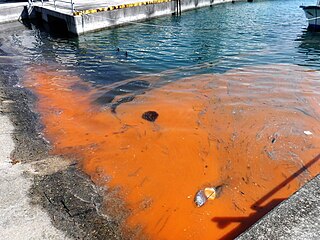
Red tide is a common name for algal blooms, which are large concentrations of aquatic microorganisms, such as protozoans and unicellular algae. The upwelling of nutrients from the sea floor, often following massive storms, provides for the algae and triggers bloom events. Harmful algal blooms can occur worldwide, and natural cycles can vary regionally.

An algal bloom or algae bloom is a rapid increase or accumulation in the population of algae in freshwater or marine water systems, and is often recognized by the discoloration in the water from their pigments. The term algae encompasses many types of aquatic photosynthetic organisms, both macroscopic, multicellular organisms like seaweed and microscopic, unicellular organisms like cyanobacteria. Algal bloom commonly refers to rapid growth of microscopic, unicellular algae, not macroscopic algae. An example of a macroscopic algal bloom is a kelp forest.
Pfiesteria piscicida is a dinoflagellate species of the genus Pfiesteria that some researchers claim is responsible for many harmful algal blooms in the 1980s and 1990s on the coast of North Carolina and Maryland. Piscicida means "fish-killer".

Pfiesteria is a genus of heterotrophic dinoflagellates that has been associated with harmful algal blooms and fish kills. Pfiesteria complex organisms (PCOs) were claimed to be responsible for large fish kills in the 1980s and 1990s on the coast of North Carolina and in tributaries of the Chesapeake Bay. In reaction to the toxic outbreaks, six states along the US east coast have initiated a monitoring program to allow for rapid response in the case of new outbreaks and to better understand the factors involved in Pfiesteria toxicity and outbreaks. New molecular detection methods have revealed that Pfiesteria has a worldwide distribution.
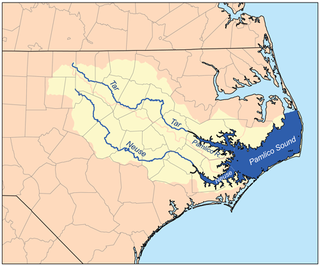
The Neuse River is a river rising in the Piedmont of North Carolina and emptying into Pamlico Sound below New Bern. Its total length is approximately 275 miles (443 km), making it the longest river entirely contained in North Carolina. The Trent River joins the Neuse at New Bern. Its drainage basin, measuring 5,630 square miles (14,600 km2) in area, also lies entirely inside North Carolina. It is formed by the confluence of the Flat and Eno rivers prior to entering the Falls Lake reservoir in northern Wake County. Its fall line shoals, known as the Falls of the Neuse, lie submerged under the waters of Falls Lake.

Cyanotoxins are toxins produced by bacteria called cyanobacteria. Cyanobacteria are found almost everywhere, but particularly in lakes and in the ocean where, under high concentration of phosphorus conditions, they reproduce exponentially to form blooms. Blooming cyanobacteria can produce cyanotoxins in such concentrations that they poison and even kill animals and humans. Cyanotoxins can also accumulate in other animals such as fish and shellfish, and cause poisonings such as shellfish poisoning.

Pseudopfiesteria shumwayae is a species of heterotrophic dinoflagellates in the genus Pseudopfiesteria. It was first characterized in North Carolina in 2000. It can acquire the ability for photosynthesis through eating green algae and retaining their chloroplasts. It can also turn predatory and toxic strains of Pseudopfiesteria shumwayae have been implicated in fish kills around the US east coast. Pseudopfiesteria shumwayae has been described as having a less complex life cycle than Pfiesteria piscicida.

The term fish kill, known also as fish die-off, refers to a localized die-off of fish populations which may also be associated with more generalized mortality of aquatic life. The most common cause is reduced oxygen in the water, which in turn may be due to factors such as drought, algae bloom, overpopulation, or a sustained increase in water temperature. Infectious diseases and parasites can also lead to fish kill. Toxicity is a real but far less common cause of fish kill.
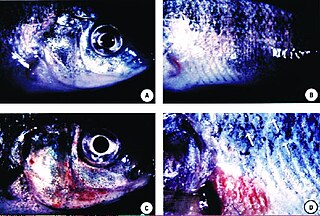
Predatory dinoflagellates are predatory heterotrophic or mixotrophic alveolates that derive some or most of their nutrients from digesting other organisms. About one half of dinoflagellates lack photosynthetic pigments and specialize in consuming other eukaryotic cells, and even photosynthetic forms are often predatory.

Like humans and other animals, fish suffer from diseases and parasites. Fish defences against disease are specific and non-specific. Non-specific defences include skin and scales, as well as the mucus layer secreted by the epidermis that traps microorganisms and inhibits their growth. If pathogens breach these defences, fish can develop inflammatory responses that increase the flow of blood to infected areas and deliver white blood cells that attempt to destroy the pathogens.
Alexandrium monilatum is a species of armored, photosynthetic, marine dinoflagellates. It produces toxins that, when present in high concentrations as "red tides", can kill fish and reduce growth rates of shellfish.
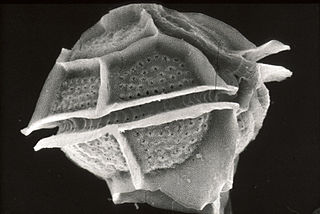
Pyrodinium was first discovered in 1906 in the waters around New Providence Island in the Bahamas. Pyrodinium is a monospecific species with two varieties, Pyrodinium bahamense var. compressum and Pyrodinium bahamanse var. bahamense. Pyrodinium is well known for producing Paralytic Shellfish Toxins (PSTs), e.g. saxitoxin, and the bioluminescence that lights up the bioluminescent bays in Puerto Rico and the Bahamas.
Dinotoxins are a group of toxins which are produced by flagellate, aquatic, unicellular protists called dinoflagellates. Dinotoxin was coined by Hardy and Wallace in 2012 as a general term for the variety of toxins produced by dinoflagellates. Dinoflagellates are an enormous group of marine life, with much diversity. With great diversity comes many different toxins, however, there are a few toxins that multiple species have in common.
Gambierdiscus caribaeus is a species of toxic dinoflagellates, which among others causes ciguatera fish poisoning. It is photosynthetic and epibenthic.
Gambierdiscus carpenteri is a species of toxic dinoflagellate, which among others causes ciguatera fish poisoning. It is photosynthetic and epibenthic.
Gambierdiscus ruetzleri is a species of toxic dinoflagellates, which among others causes ciguatera fish poisoning. It is photosynthetic and epibenthic.

Gambierdiscus is a genus of marine dinoflagellates that produce ciguatoxins, a type of toxin that causes the foodborne illness known as ciguatera. They are usually epiphytic on macroalgae growing on coral reefs.
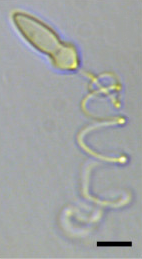
Polykrikos is one of the genera of family Polykrikaceae that includes athecate pseudocolony-forming dinoflagellates. Polykrikos are characterized by a sophisticated ballistic apparatus, named the nematocyst-taeniocyst complex, which allows species to prey on a variety of organisms. Polykrikos have been found to regulate algal blooms as they feed on toxic dinoflagellates. However, there is also some data available on Polykrikos being toxic to fish.
Alexandrium ostenfeldii, also known as the sea fire, is a species of dinoflagellates. It is among the group of Alexandrium species that produce toxins cause paralytic shellfish poisoning. These organisms have been found in the Baltic Sea.
Lois Ann Pfiester (1936–1992) was an American phycologist and protistologist, specializing in freshwater dinoflagellate species.
References
- ↑ Mann, Charles C. (April 27, 1997). "Books: Wet and Nasty". New York Times.
- ↑ Burkholder, JoAnn M.; Glasgow, Howard B. (2001). "History of Toxic Pfiesteria in North Carolina Estuaries from 1991 to the Present". BioScience. 51 (10): 827. doi: 10.1641/0006-3568(2001)051[0827:hotpin]2.0.co;2 . ISSN 0006-3568.
- ↑ Broad, William J. (March 27, 1997). "In a Sealed Lab, A Warrior Against Pollution". New York Times.
- ↑ Burkholder, Joann M; Glasgow, Howard B (1999). "Science Ethics and its Role in Early Suppression of the Pfiesteria Issue". Human Organization. 58 (4): 443–455. doi:10.17730/humo.58.4.976098q356672751. JSTOR 44127660.
- ↑ Burkholder, Joann M.; Glasgow, Howard B.; Deamer-Mella, Nora (2001). "Overview and present status of the toxic Pfiesteria complex (Dinophyceae)". Phycologia. 40 (3): 186–214. doi:10.2216/i0031-8884-40-3-186.1. ISSN 0031-8884.